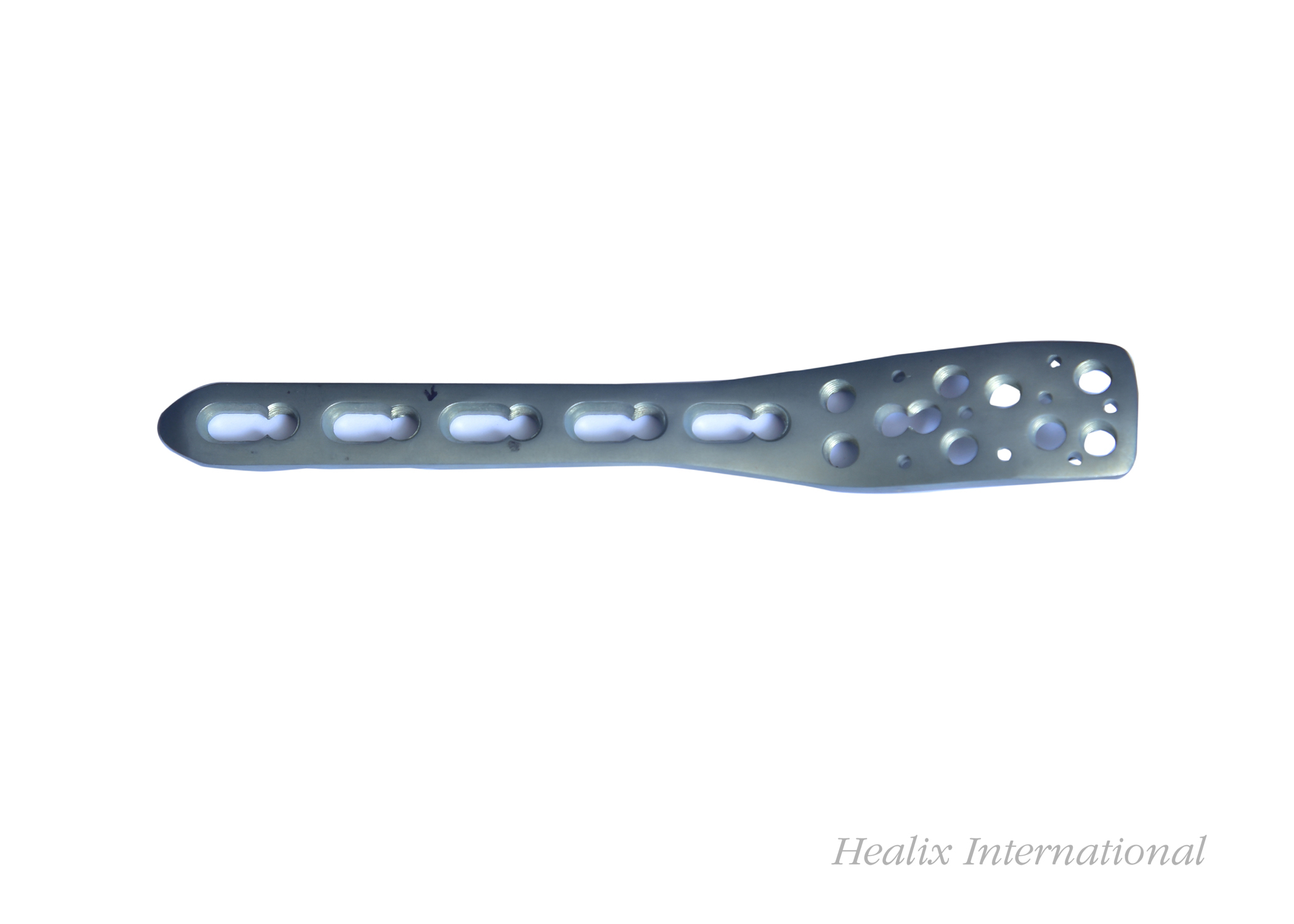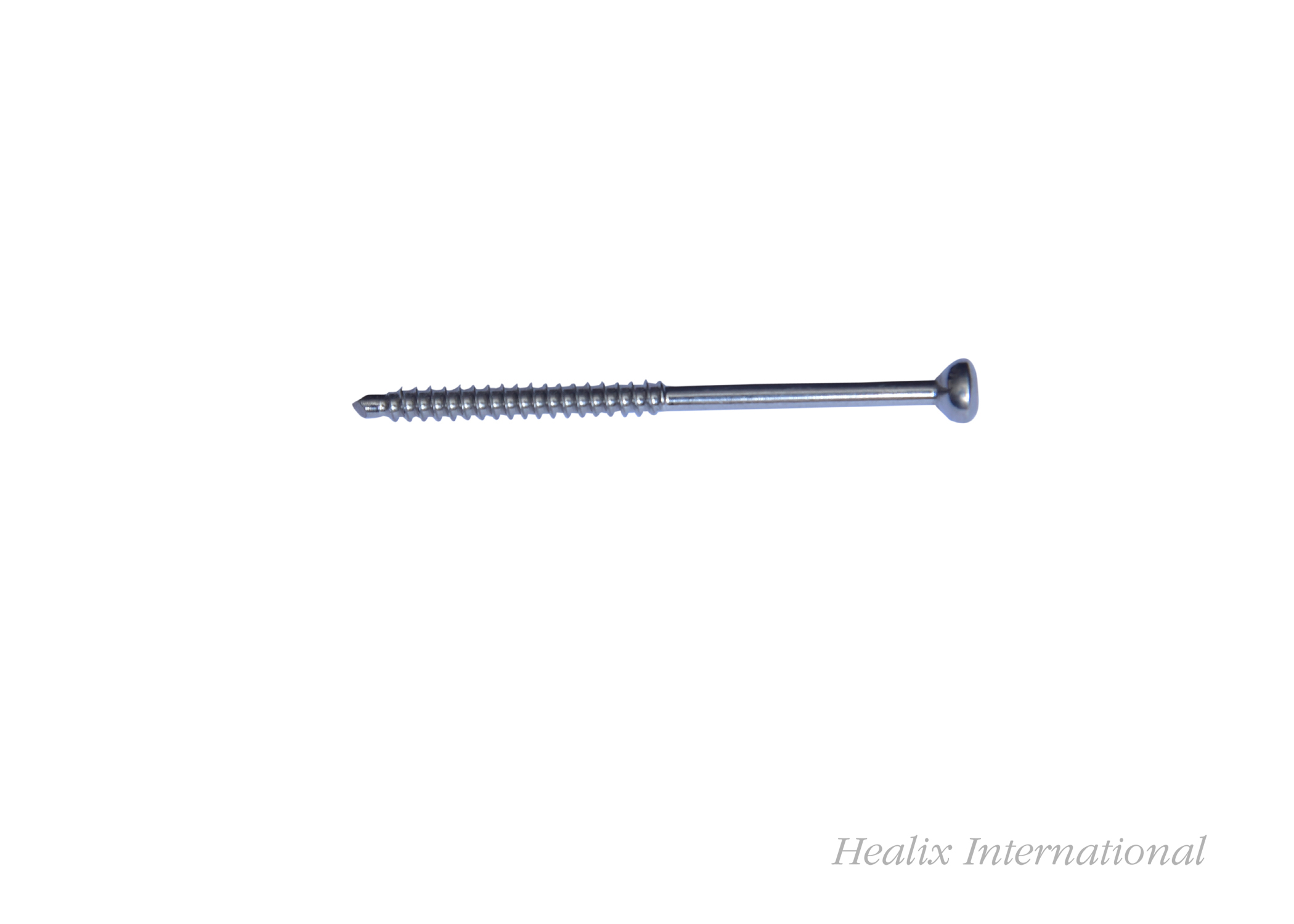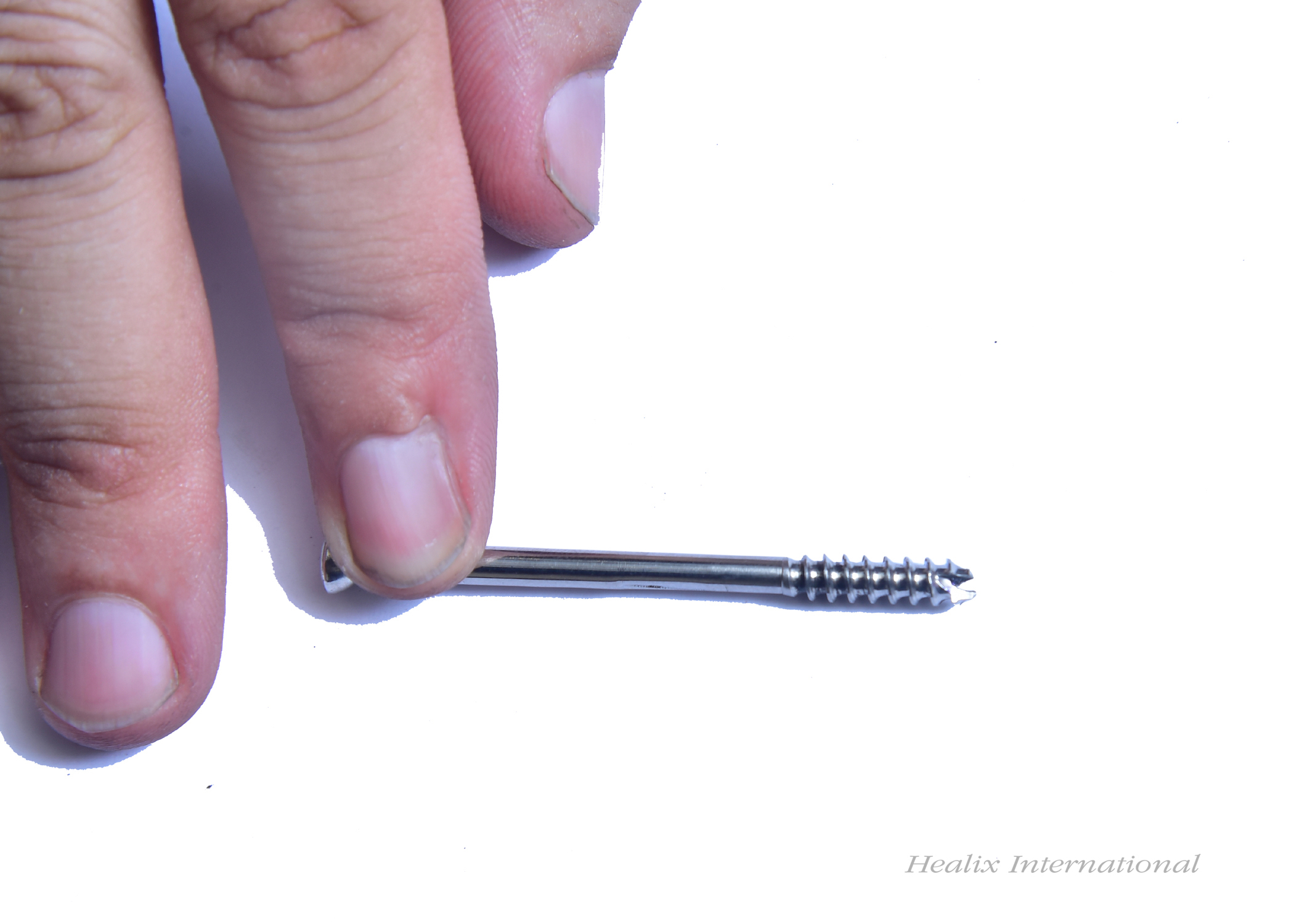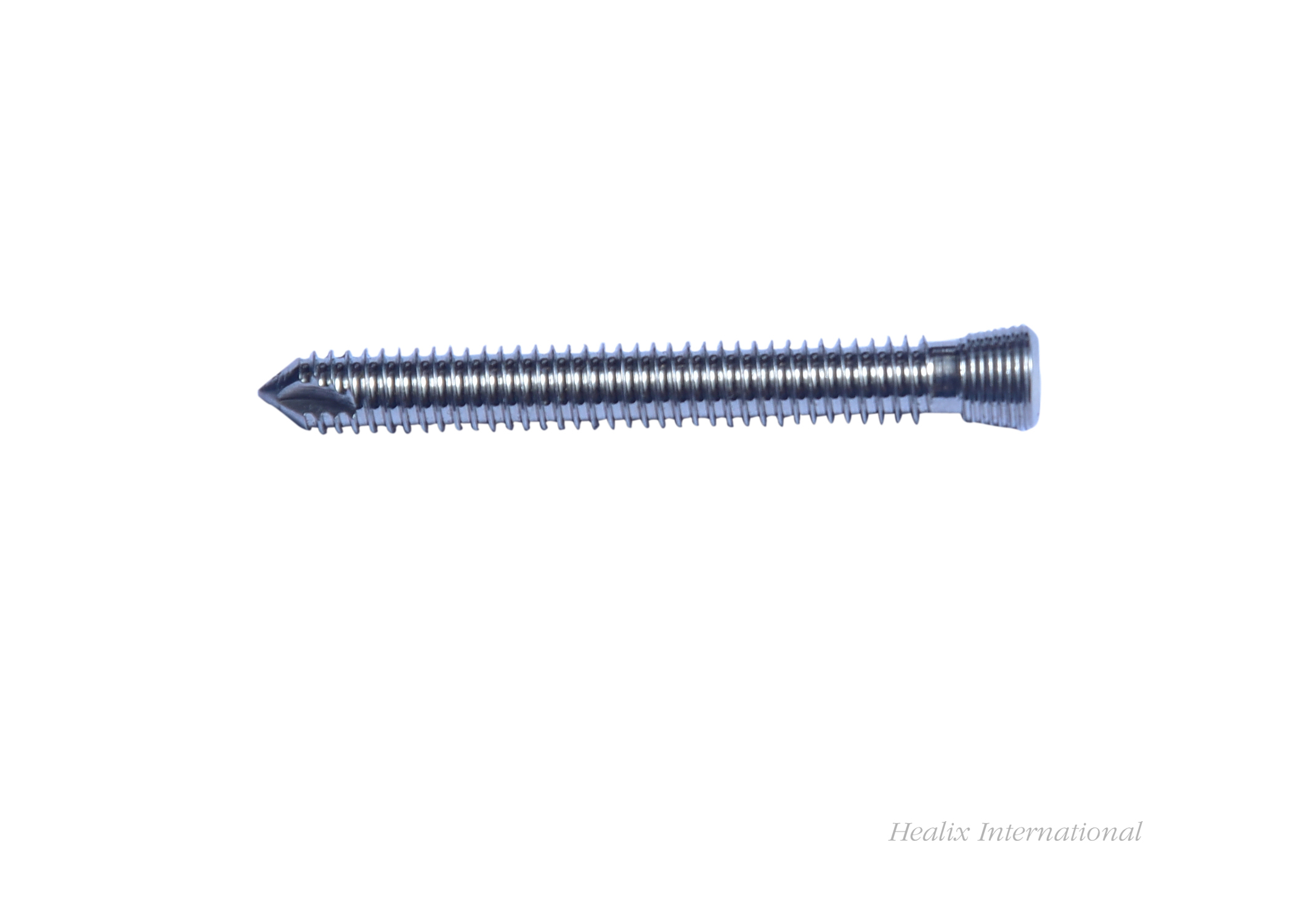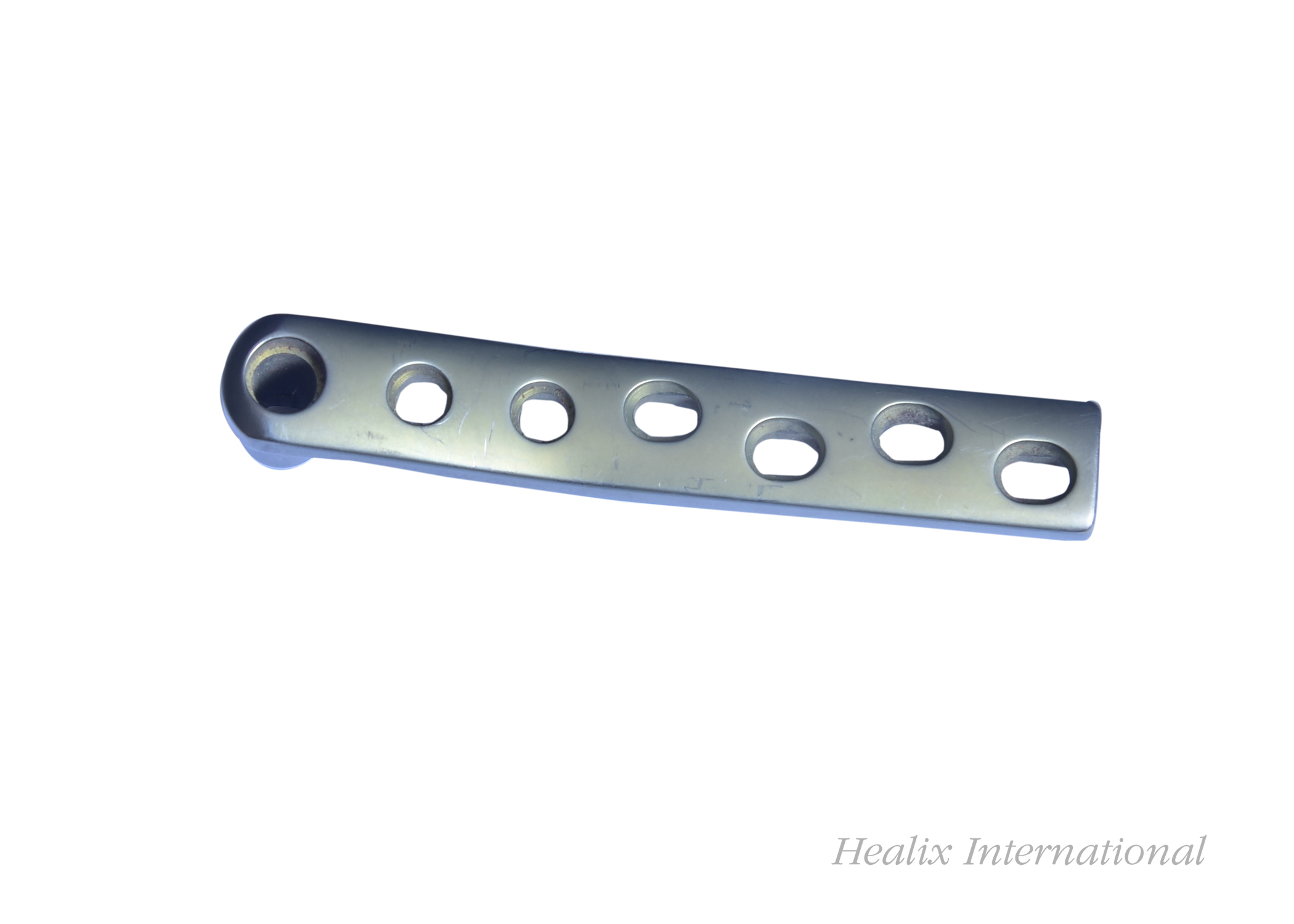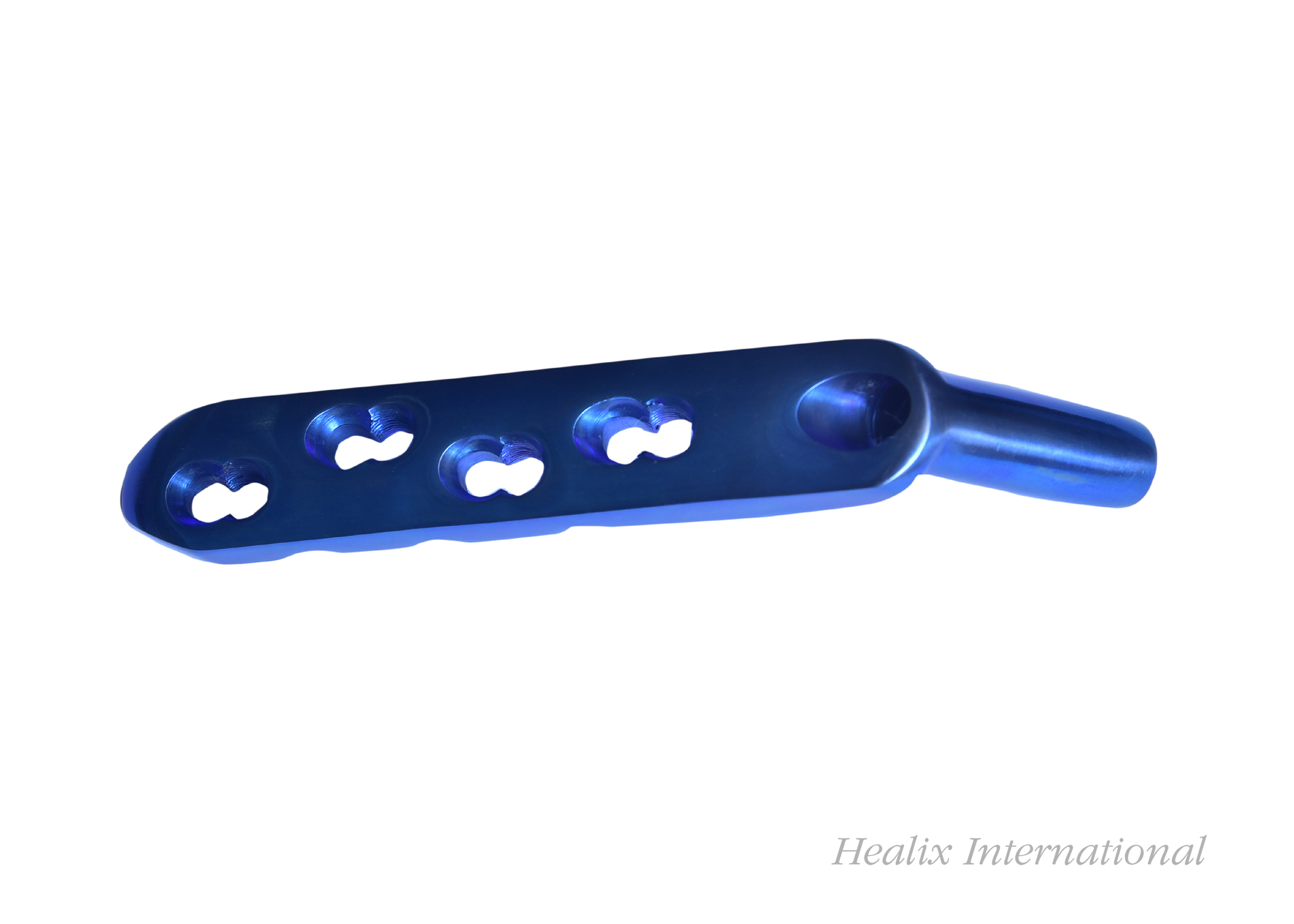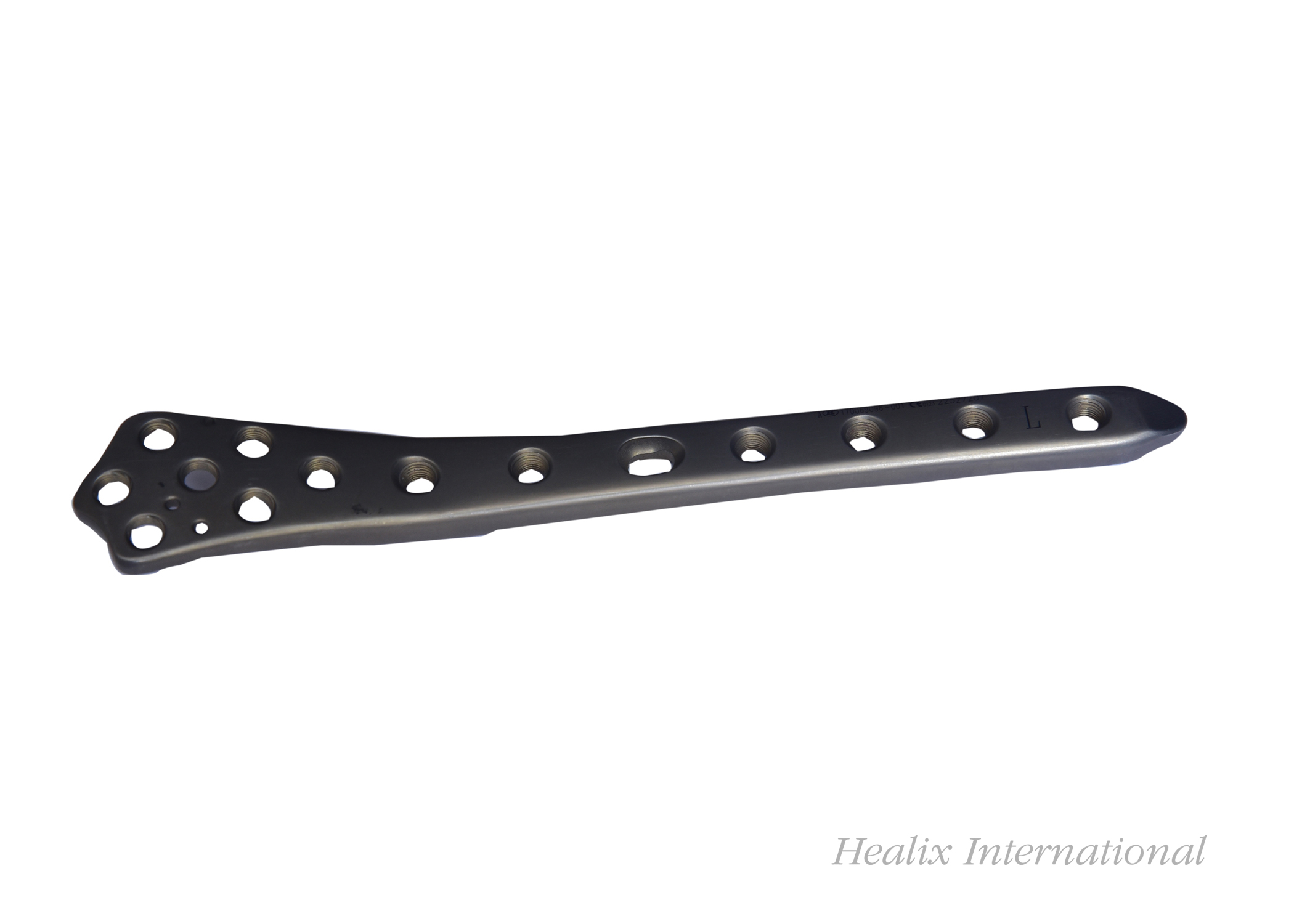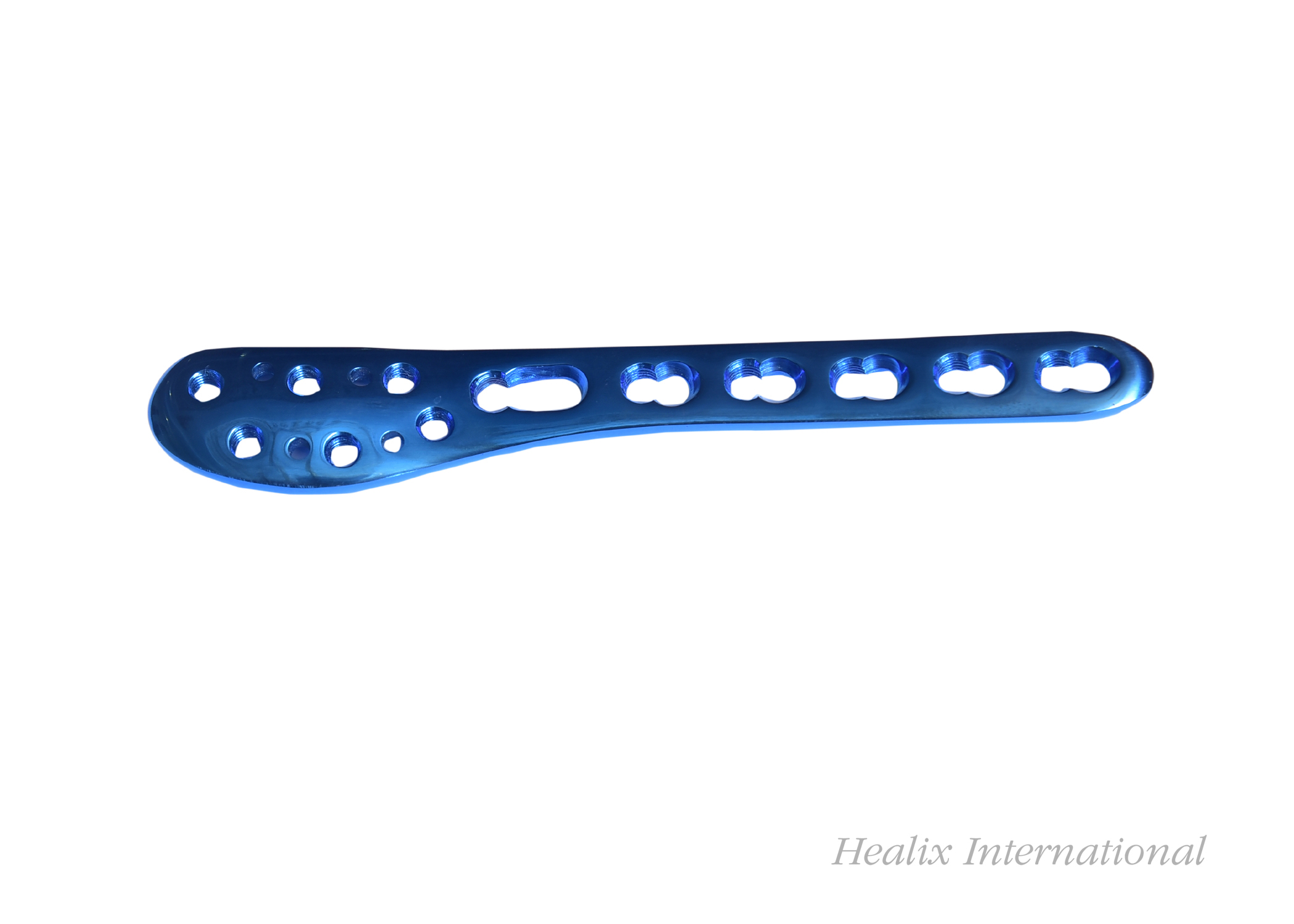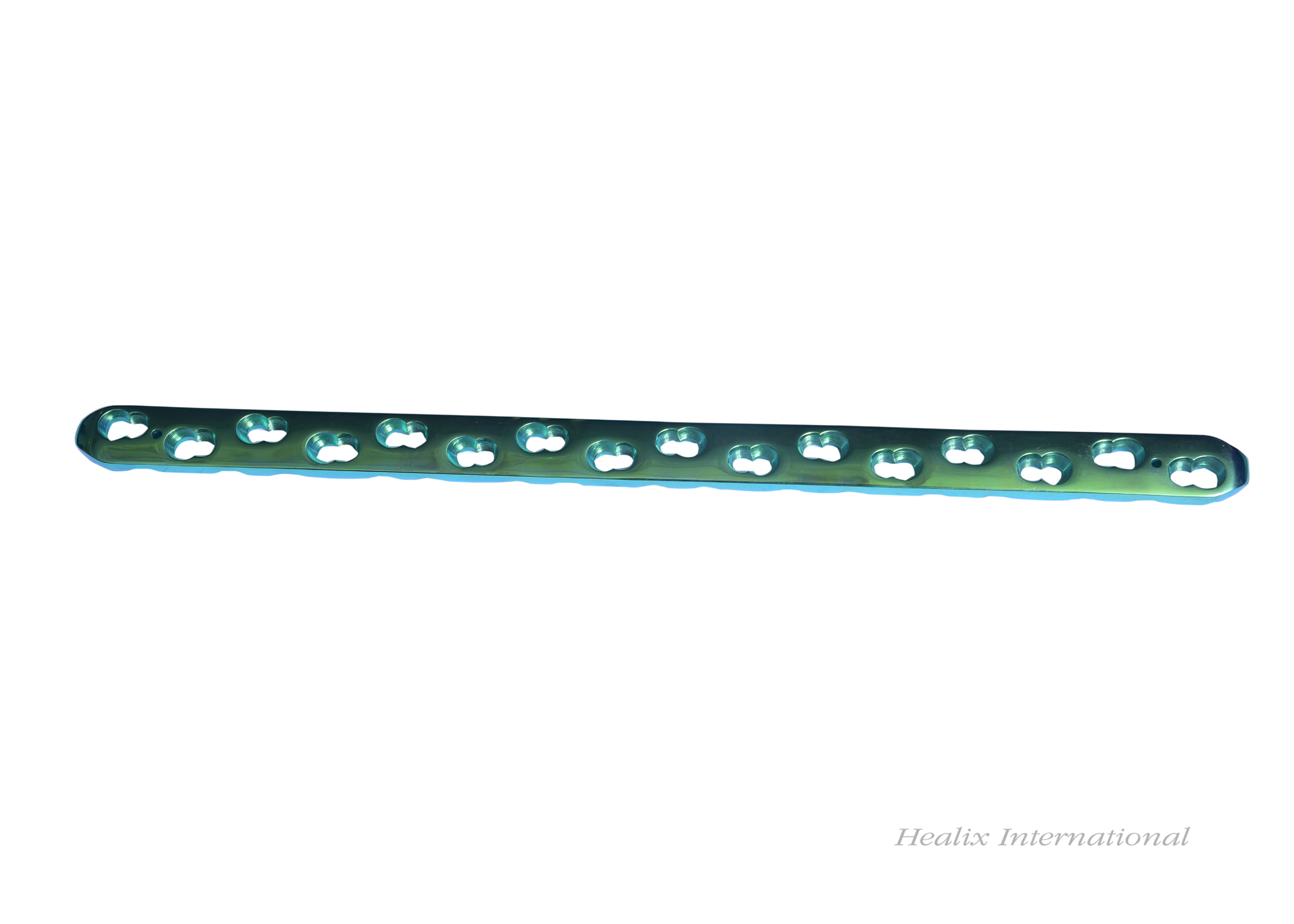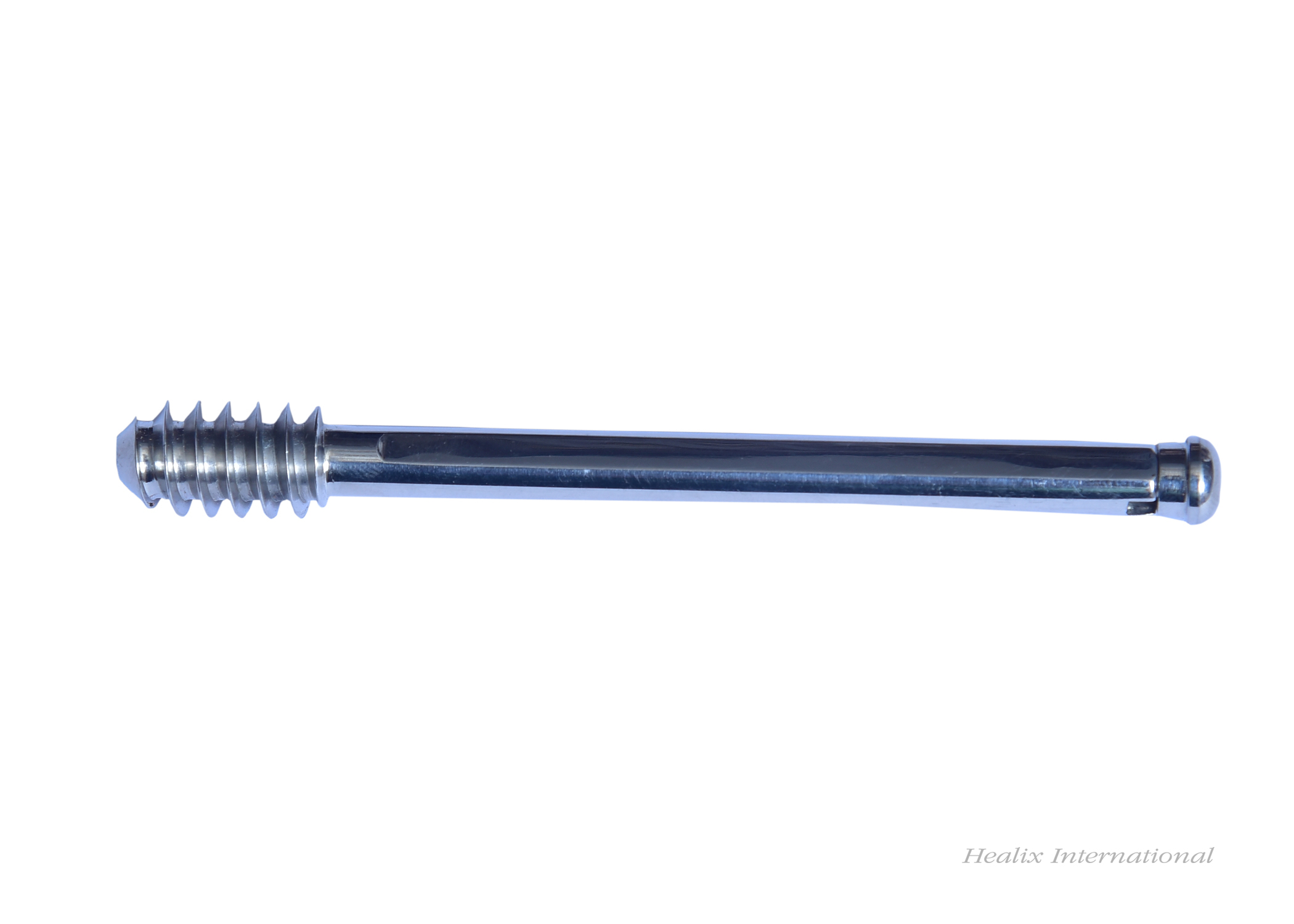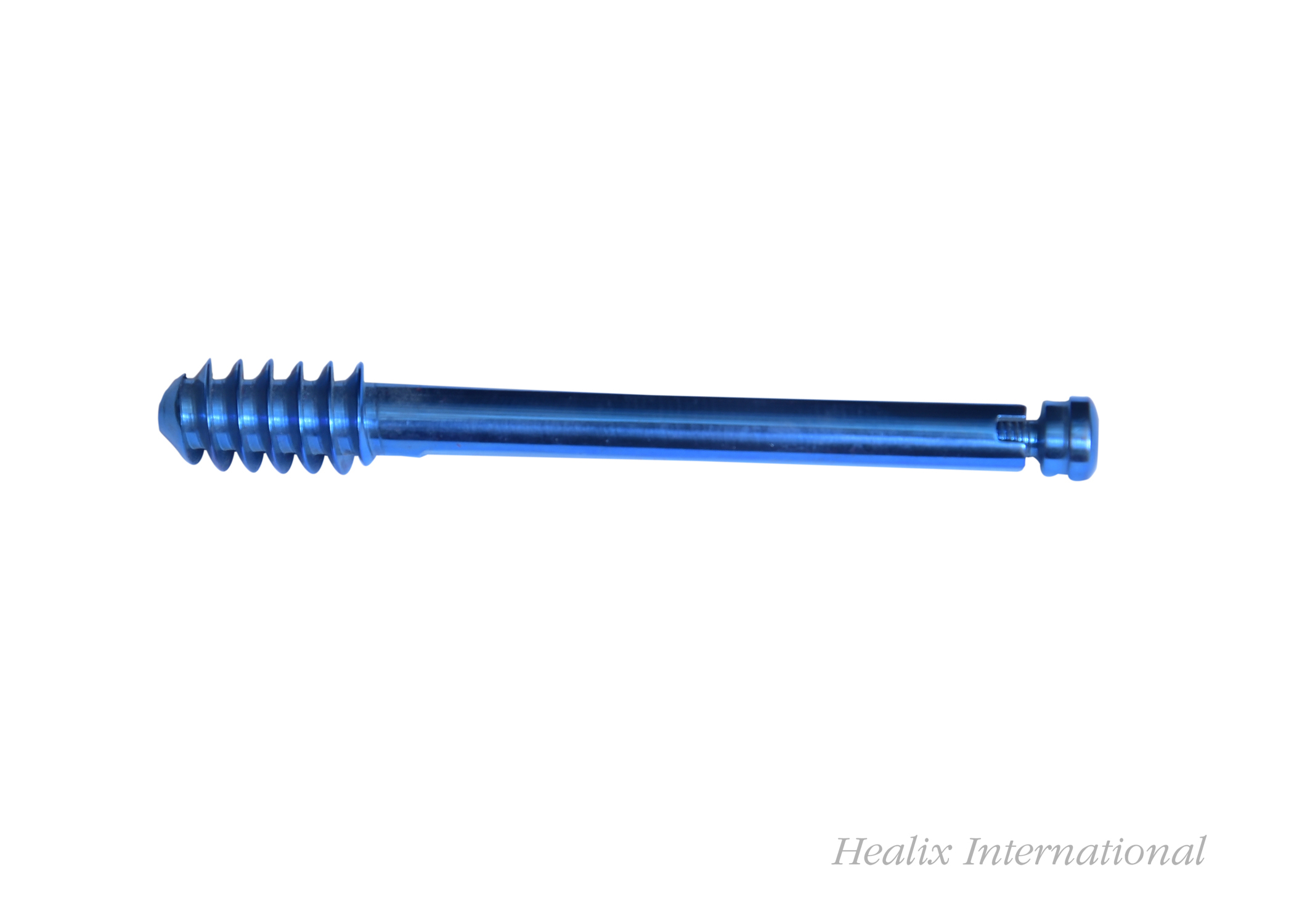Showing 13–24 of 31 results
-
3.5mm Proximal Humerus Plate
Original price was: £186.08.£130.00Current price is: £130.00.- Size: The plate is 3.5mm thick, making it a relatively thin plate suitable for use in smaller bones or delicate areas.
- Material: The plate appears to be made of titanium, a common material used in orthopedic implants due to its strength and biocompatibility. The blue color is likely due to a coating or treatment applied to the plate.
- Shape: The plate has a distinctive shape designed to match the anatomy of the proximal humerus bone. It has a broad, flat portion with multiple holes for screw fixation, and a narrower, curved portion that extends towards the proximal end of the humerus.
- Holes: The plate has evenly spaced holes along its length, which are likely used for securing the plate to the bone with screws.
-
4.5mm Malleolar Screw SS
£160.96- Size: The screw has a diameter of 4.5mm, making it a relatively small screw suitable for use in smaller bones or delicate areas.
- Material: The screw is made of stainless steel, a common material used in orthopedic implants due to its strength and biocompatibility.
- Shape: The screw has a cylindrical body with a sharp tip for easy insertion into bone. It also features a distinct head with a flat top, which likely has a slot for a screwdriver or a specialized tool for tightening the screw.
- Thread: The screw has a threaded shaft, which helps to secure it in place within the bone and provides a strong mechanical hold. Malleolar screws are specifically designed for use in the malleolar region of the ankle, where the tibia and fibula bones meet.
- Special Features: Malleolar screws often have a unique thread pattern or design to provide optimal purchase in the dense cortical bone of the malleoli.
-
4mm Cannulated Screw SS
Original price was: £196.46.£137.00Current price is: £137.00.- Size: The screw has a diameter of 4mm, making it a relatively small screw suitable for use in smaller bones or delicate areas.
- Material: The screw is made of stainless steel, a common material used in orthopedic implants due to its strength and biocompatibility.
- Shape: The screw has a cylindrical body with a sharp tip for easy insertion into bone. It also features a distinct head with a flat top, which likely has a slot for a screwdriver or a specialized tool for tightening the screw.
- Thread: The screw has a threaded shaft, which helps to secure it in place within the bone and provides a strong mechanical hold.
- Cannulation: The most distinctive feature of this screw is the cannulation. This means that the screw has a hollow channel running through its center. This cannulation allows for the passage of a guidewire or other instruments, which can be helpful during surgical procedures, especially in cases where precise placement is critical.
-
5mm Inter Locking Screw
£194.89- Size: The screw has a diameter of 5mm, making it a relatively small screw suitable for use in smaller bones or delicate areas.
- Material: The screw appears to be made of stainless steel, a common material used in orthopedic implants due to its strength and biocompatibility.
- Shape: The screw has a cylindrical body with a sharp tip for easy insertion into bone. It also features a distinct head with a flat top, which likely has a slot for a screwdriver or a specialized tool for tightening the screw.
- Thread: The screw has a threaded shaft, which helps to secure it in place within the bone and provides a strong mechanical hold. Interlocking screws are designed to be used in conjunction with interlocking plates. They have a special thread pattern that allows them to engage with the plate’s holes, preventing the screw from backing out and providing a more secure fixation.
-
5mm Locking Screw SS
Original price was: £145.93.£101.00Current price is: £101.00.- Size: The screw has a diameter of 5mm, making it a relatively small screw suitable for use in smaller bones or delicate areas.
- Material: The screw is made of stainless steel, a common material used in orthopedic implants due to its strength and biocompatibility.
- Shape: The screw has a cylindrical body with a sharp tip for easy insertion into bone. It also features a distinct head with a flat top, which likely has a slot for a screwdriver or a specialized tool for tightening the screw.
- Thread: The screw has a threaded shaft, which helps to secure it in place within the bone and provides a strong mechanical hold.
- Locking Mechanism: The most distinctive feature of this screw is the locking mechanism. The head of the screw appears to have a small hole or channel. This is where a locking pin or screw would be inserted to prevent the screw from backing out. This locking mechanism is crucial for ensuring the stability of the implant.
-
DCS Plate 95 Degree
Original price was: £158.68.£110.00Current price is: £110.00.- Size: The plate appears to be 3.5mm thick, making it a relatively thin plate suitable for use in smaller bones or delicate areas.
- Material: The plate appears to be made of stainless steel, a common material used in orthopedic implants due to its strength and biocompatibility.
- Shape: The plate has a distinctive curved shape with a 95-degree angle, designed to match the anatomy of specific bone areas, likely the distal femur or tibia.
- Holes: The plate has evenly spaced holes along its length, which are likely used for securing the plate to the bone with screws.
- Locking Mechanism: It’s possible that the plate is designed to be used with locking screws, as indicated by the larger oval-shaped holes. These screws have a special thread that engages with the plate, preventing them from backing out and providing a more secure fixation.
-
DHS Locking Plate Long Barrel
£150.00 – £160.00- Size: The plate is available in two sizes: 38mm and 25mm. The thickness is likely 3.5mm, making it suitable for various bone sizes and surgical procedures.
- Material: The plate appears to be made of titanium, a common material used in orthopedic implants due to its strength and biocompatibility. The blue color is likely due to a coating or treatment applied to the plate.
- Shape: The plate has a distinctive L-shape, designed to match the anatomy of the distal femur bone. It has a long, straight portion that runs along the lateral side of the femur, and a shorter, curved portion that extends towards the medial side. This shape provides stability and support to the distal femur.
- Holes: The plate has evenly spaced holes along its length, which are likely used for securing the plate to the bone with locking screws. The number of holes can vary from 3 to 20, depending on the specific plate size and configuration.
- Angles: The plate is available in various angles, including 130, 135, 140, and 145 degrees. This allows for precise anatomical fit and optimal bone alignment.
- Locking Mechanism: The plate is designed to be used with locking screws. These screws have a special thread that engages with the plate, preventing them from backing out and providing a more secure fixation.
-
Distal Femur Plate SS
£100.00- Size: The plate appears to be 3.5mm thick, making it a relatively thin plate suitable for use in smaller bones or delicate areas.
- Material: The plate is made of stainless steel, a common material used in orthopedic implants due to its strength and biocompatibility.
- Shape: The plate has a distinctive shape designed to match the anatomy of the distal femur bone. It has a long, straight portion that runs along the lateral side of the femur, and a shorter, curved portion that extends towards the medial side. This shape provides stability and support to the distal femur.
- Holes: The plate has evenly spaced holes along its length, which are likely used for securing the plate to the bone with screws.
- Locking Mechanism: It’s possible that the plate is designed to be used with locking screws, as indicated by the larger oval-shaped holes. These screws have a special thread that engages with the plate, preventing them from backing out and providing a more secure fixation.
-
Distal Fibula Plate TT
£100.00- Size: The plate appears to be 3.5mm thick, making it a relatively thin plate suitable for use in smaller bones or delicate areas.
- Material: The plate appears to be made of titanium, a common material used in orthopedic implants due to its strength and biocompatibility. The blue color is likely due to a coating or treatment applied to the plate.
- Shape: The plate has a distinctive shape designed to match the anatomy of the distal fibula bone. It has a long, straight portion that runs along the lateral side of the fibula, and a shorter, curved portion that extends towards the medial side. This shape provides stability and support to the distal fibula.
- Holes: The plate has evenly spaced holes along its length, which are likely used for securing the plate to the bone with screws.
- Locking Mechanism: The plate is likely designed to be used with locking screws, as indicated by the larger oval-shaped holes. These screws have a special thread that engages with the plate, preventing them from backing out and providing a more secure fixation.
-
LCP-DCP Broad Plate TT (4.5mm)
£100.00The LCP-DCP Broad Plate TT is a versatile orthopedic implant designed for various bone fracture and osteotomy procedures. It combines the principles of Limited Contact Dynamic Compression Plate (LC-DCP) and Locking Compression Plate (LCP) technologies.
-
Leg Screw SS
£100.00- Size: The screw appears to be 6.5mm in diameter, making it a relatively large screw suitable for use in larger bones.
- Material: The screw is made of stainless steel, a common material used in orthopedic implants due to its strength and biocompatibility.
- Shape: The screw has a cylindrical body with a sharp tip for easy insertion into bone. It also features a distinct head with a flat top, which likely has a slot for a screwdriver or a specialized tool for tightening the screw.
- Thread: The screw has a threaded shaft, which helps to secure it in place within the bone and provides a strong mechanical hold. The thread pattern on leg screws is designed to engage with cortical bone, which is the dense outer layer of bone.
- Cannulation: The screw has a hollow channel running through its center. This cannulation allows for the passage of a guidewire or other instruments, which can be helpful during surgical procedures, especially in cases where precise placement is critical.
-
Leg Screw TT
£100.00- Size: The screw appears to be 6.5mm in diameter, making it a relatively large screw suitable for use in larger bones.
- Material: The screw appears to be made of titanium, a common material used in orthopedic implants due to its strength and biocompatibility. The blue color is likely due to a coating or treatment applied to the screw.
- Shape: The screw has a cylindrical body with a sharp tip for easy insertion into bone. It also features a distinct head with a flat top, which likely has a slot for a screwdriver or a specialized tool for tightening the screw.
- Thread: The screw has a threaded shaft, which helps to secure it in place within the bone and provides a strong mechanical hold. The thread pattern on leg screws is designed to engage with cortical bone, which is the dense outer layer of bone.
- Cannulation: The screw has a hollow channel running through its center. This cannulation allows for the passage of a guidewire or other instruments, which can be helpful during surgical procedures, especially in cases where precise placement is critical.

